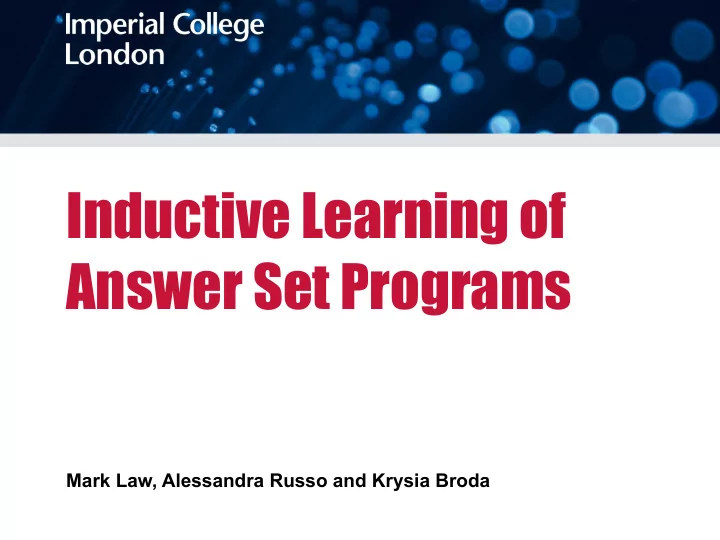

Inductive Learning of Answer Set Programs � Mark Law, Alessandra Russo and Krysia Broda
Inductive Logic Programming The task of Inductive Logic Programming (ILP) is to find a hypothesis H which “explains” a set of positive and negative examples ( E + and E - ) with respect to a background knowledge B . � The work on nonmonotonic ILP under the Answer Set/Stable Model semantics has mostly been limited to learning normal logic programs and is usually restricted to either brave or cautious reasoning. � Our new learning task, Learning from Answer Sets, incorporates both brave and cautious reasoning with the aim of learning Answer Set Programs containing normal rules, choice rules and constraints.
Sudoku Example + ve − ve − ve complete 1 { value(1, C), value(2, C), value(3, C), value(4, C) } 1 :- cell(C). :- value(V, C1), value(V, C2), same_row(C1, C2). :- value(V, C1), value(V, C2), same_block(C1, C2). :- value(V, C1), value(V, C2), same_col(C1, C2).
Comparison with related works under the Answer Set semantics Normal Choice Classical Algorithm for Learning Task Constraints Brave Cautious Rules Rules negation optimal solutions Brave Induction ✔ ✔ ✖ ✔ ✔ ✖ ✖ [Sakama, Inoue 2009] Cautious Induction ✔ ✔ ✖ ✔ ✖ ✔ ✖ [Sakama, Inoue 2009] XHAIL [Ray 2009] ✔ ✖ ✖ ✖ ✔ ✖ ✔ & ASPAL [Corapi, Russo, Lupu 2011] Induction of Stable Models ✔ ✖ ✖ ✖ ✔ ✖ ✖ [Otero 2001] Induction from ✔ ✖ ✔ ✔ ✔ ✔ ✖ Answer Sets [Sakama 2005] ✔ ✔ ✔ ✖ ✔ ✔ ✔ LAS
Learning from Answer Sets A partial interpretation E is a pair of sets of atoms h E inc , E exc i called the inclusions and exclusions respectively. An Answer Set A extends h E inc , E exc i if and only if: E inc ✓ A and E exc \ A = ; . A Learning from Answer Sets task is a tuple T = h B, S M , E + , E − i where B is an ASP program, S M is the search space defined by a language bias M , E + and E − are sets of partial interpretations. A hypothesis H 2 ILP LAS h B, S M , E + , E − i if and only if: 1. H ✓ S M 2. 8 e + 2 E + 9 A 2 AS ( B [ H ) st A extends e + 3. 8 e − 2 E − 6 9 A 2 AS ( B [ H ) st A extends e −
Inductive Learning of Answer Set Programs A hypothesis H 2 positive solutions h B, S M , E + , E − i if and only if: 1. H ✓ S M 2. 8 e + 2 E + 9 A 2 AS ( B [ H ) st A extends e + A hypothesis H 2 violating solutions h B, S M , E + , E − i if and only if: 1. H ✓ S M 2. 8 e + 2 E + 9 A 2 AS ( B [ H ) st A extends e + 3. 9 e − 2 E − 9 A 2 AS ( B [ H ) st A extends e − ILP LAS h B, S M , E + , E − i = positive solutions h B, S M , E + , E − i \ violating solutions h B, S M , E + , E − i
Inductive Learning of Answer Sets Object Level Meta Representation (ASP) n : a given hypothesis length T n meta : ASP task program (a meta representation of the task T )
Inductive Learning of Answer Sets T n meta : ASP task program (a meta representation of the task T ) vs : violating solutions ps : positive solutions
Comparison with related works ILP brave h B, E i ILP ASP AL/XHAIL h B, h E, ;ii ILP ASP AL/XHAIL h B, h E + , E − ii ILP stable models h B, { h E + , E − i } i ILP stable models h B, { h E + 1 i . . . { h E + n i } i 1 , E − n , E − ILP LAS h B, { h E + 1 i . . . { h E + n i } , ;i 1 , E − n , E − ILP LAS h B, E + , E − i
Comparison with related works ILP cautious h B, { e 1 , . . . , e n } i ILP LAS h B, ; , { h; , { e 1 } i . . . h; , { e n } i } i
Current work: modification of ILASP � � • For some classes of problem there could be many violating solutions before we find an inductive solution. � • The sudoku example is one such problem, with 413044 before the first inductive solution it takes over 14 minutes to solve with ILASP. � • In fact, many of these are violating for the same reason (they share Answer Sets which extend negative examples). � • With our new system based on ruling out classes of hypothesis, we need only 7 classes and the problem is solved in less than a second. � �
Other current work � � • Expand the subset of ASP that we can learn • conditions, weighted aggregates etc. • weak constraints/optimisation statements � • Real applications • Ideally not achievable by other ILP tasks • Will motivate the work from a practical point of view • Measure the accuracy of the learning task
Recommend
More recommend